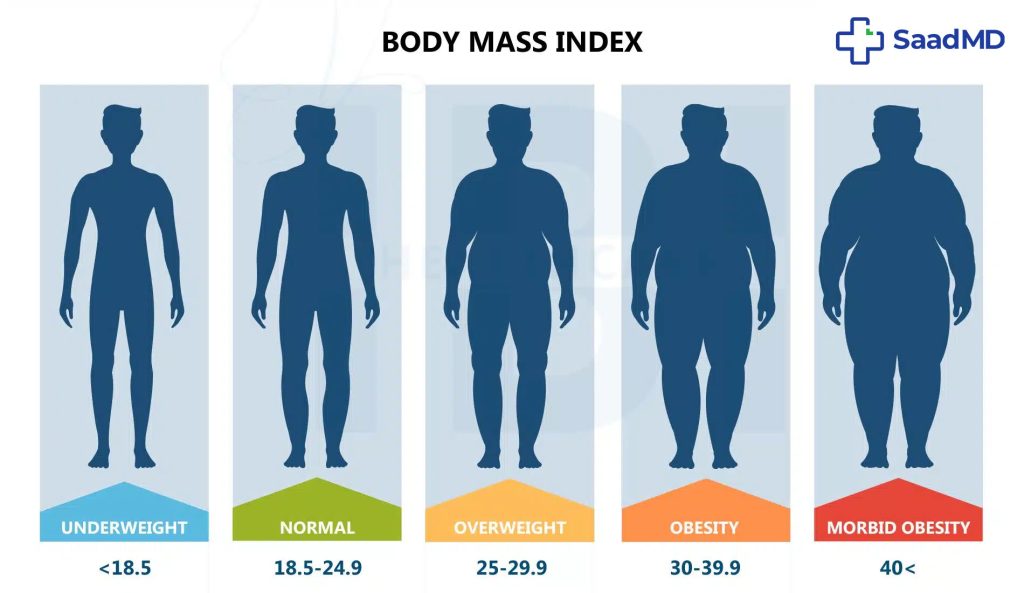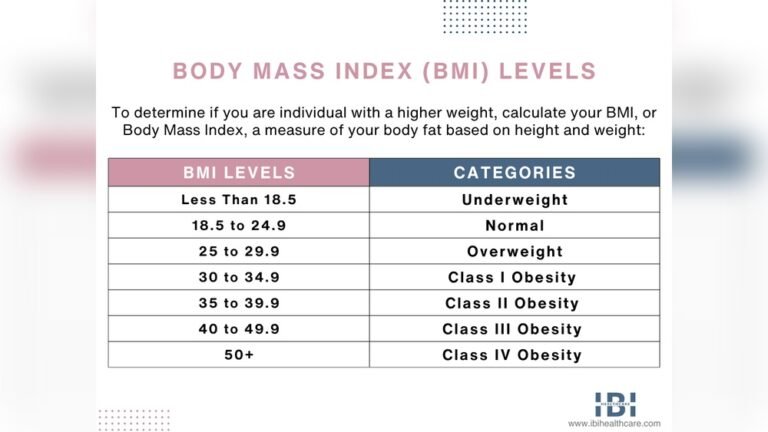Are you curious about what exactly obesity classes mean and how they might affect your health? Understanding these categories can be a key step in taking control of your well-being.
Obesity isn’t just about weight—it’s about how excess body fat impacts your body and your risk for serious health issues. By learning about the different obesity classes, you’ll discover how your Body Mass Index (BMI) helps define your risk level and what that means for your daily life.
Keep reading to find out how these classifications are made, what signs to watch for, and why knowing your obesity class could make all the difference in your journey toward better health.
Obesity Classes By Bmi
Obesity classes are defined using Body Mass Index (BMI), a simple measure based on height and weight. BMI helps categorize obesity into different levels or classes. Each class reflects the degree of excess body weight and its potential health risks.
Understanding obesity classes by BMI can guide health decisions and risk management. BMI ranges are divided into three main obesity classes. Each class indicates increasing risk for health problems related to excess weight.
Class 1: Low Risk
Class 1 obesity includes a BMI from 30.0 to 34.9. This range shows mild obesity, where risks for health issues begin to rise. People in this class may develop conditions like high blood pressure or type 2 diabetes.
Early lifestyle changes can reduce health risks in this stage. Monitoring diet and physical activity is important.
Class 2: Moderate Risk
Class 2 obesity covers a BMI between 35.0 and 39.9. This range is considered moderate risk. Health problems become more common and severe in this class.
There is a higher chance of heart disease, sleep apnea, and joint problems. Medical advice is often needed to manage weight and related health conditions.
Class 3: High Risk
Class 3 obesity starts at a BMI of 40.0 and above. This is also called severe or high-risk obesity. The chance of serious health issues greatly increases.
Conditions such as diabetes, heart disease, and stroke are more frequent. Intensive treatment and close medical supervision may be necessary to improve health outcomes.
:max_bytes(150000):strip_icc()/VWH-AmeliaManley-ObesityClasses-4000x2700-ad36a3f6697546f5ac42f59bf5f9be6b.jpg)
Credit: www.verywellhealth.com
Measuring Obesity
Measuring obesity is important to understand health risks and decide on treatment. It involves simple tools and methods to classify weight status. These measurements help identify if a person is overweight or falls into specific obesity classes. Several factors contribute to accurate assessment beyond just weight and height. Knowing these methods aids in better health management and awareness.
Role Of Bmi
BMI stands for Body Mass Index. It uses weight and height to estimate body fat. BMI is easy to calculate and widely used by doctors. It divides obesity into classes based on score ranges. Class 1 starts at a BMI of 30, Class 2 at 35, and Class 3 at 40 or above. These classes help gauge obesity severity and related health risks.
Limitations Of Bmi
BMI does not measure body fat directly. It can misclassify muscular people as obese. Older adults may have low muscle but high fat, which BMI misses. BMI ignores fat distribution, which affects health differently. Using BMI alone may not give a full picture of someone’s health status.
Other Assessment Factors
Waist circumference shows abdominal fat and risk for disease. Body shape matters; “apple-shaped” bodies carry more health risks. Physical signs like skin changes or fatigue may indicate obesity effects. Activity level and diet also influence obesity assessment. Doctors often combine these factors for a clearer diagnosis.
Physical Signs Of Obesity
Obesity shows itself through clear physical signs. These signs help identify the class of obesity a person may have. Recognizing these signs aids in understanding health risks and the need for medical attention.
Body Shape Patterns
Obesity often changes body shape. The most common pattern is the “apple shape.” Fat gathers around the waist and belly. This shape raises risks for heart disease and diabetes.
Another pattern is the “pear shape.” Fat collects around the hips and thighs. Though less risky than apple shape, it still affects mobility and health.
Body shape gives clues about fat distribution. It also signals which obesity class a person might belong to.
Common Physical Symptoms
Extra weight causes physical symptoms that vary by obesity class. Swelling in the legs and feet is common. It happens due to poor blood flow and pressure on veins.
Skin changes appear too. Stretch marks and dark patches can form, especially in skin folds. These signs show stress on the skin from excess fat.
Breathlessness and fatigue occur even with little activity. This happens as the body works harder to move and breathe. Joint pain is frequent due to extra strain on bones.
Health Risks Linked To Classes
Obesity classes indicate levels of excess body weight linked to different health risks. As the obesity class increases, so does the chance of developing serious health problems. Understanding these risks helps in managing and preventing complications effectively.
Joint And Nerve Issues
Extra weight strains joints, especially knees and hips. This pressure causes pain and limits movement. It can lead to osteoarthritis, a condition that wears down joint cartilage. Nerves may get compressed, causing numbness or tingling. Carpal tunnel syndrome is common in people with higher obesity classes.
Metabolic Disturbances
Obesity affects how the body processes sugar and fat. Insulin resistance can develop, raising the risk of type 2 diabetes. High blood sugar damages organs over time. Fat buildup around organs disrupts hormone balance. Metabolic syndrome, a cluster of conditions, becomes more likely with higher obesity classes.
Cardiovascular Concerns
Carrying excess weight stresses the heart and blood vessels. Blood pressure often rises, increasing the chance of heart attacks. High cholesterol levels are common, clogging arteries. This narrows blood flow and can cause strokes. Severe obesity classes greatly raise the risk of heart failure and other cardiac diseases.
Metabolic Types Of Obesity
Obesity is not just one condition. It has different metabolic types that explain why people gain weight differently. Understanding these types helps in managing weight better. Each type has unique causes and patterns.
Hungry Brain
The hungry brain type means the brain signals hunger too often. People feel hungry even after eating enough. This leads to eating more calories than needed. The brain’s reward system often drives food cravings here.
Hungry Gut
Hungry gut happens when the stomach empties too quickly. This causes hunger signals to reach the brain fast. People may feel hungry soon after meals. It can cause frequent snacking and overeating.
Emotional Hunger
Emotional hunger is linked to feelings, not actual hunger. Stress, sadness, or boredom can trigger eating. Food acts as comfort, causing weight gain. This type needs attention to mental health and habits.
Slow Burn
Slow burn means a slow metabolism. The body burns fewer calories at rest. This causes weight to build up over time. Exercise and diet changes are important for this type.
Impact On Daily Life
Obesity classes affect many parts of daily life. These impacts can change how people move, feel, and think. Understanding these effects helps in managing health better. The challenges go beyond just weight. They touch on physical abilities and mental well-being.
Physical Limitations
Obesity often reduces the body’s ability to move freely. Simple tasks like walking or climbing stairs can become hard. Joint pain and muscle strain are common problems. These issues can limit daily activities and reduce energy. Over time, physical activity may decrease, which worsens health.
Higher obesity classes usually mean greater physical challenges. Carrying extra weight stresses the heart and lungs. This can cause shortness of breath and fatigue. Sleep problems like sleep apnea are also common. These factors make it tough to stay active and healthy.
Emotional And Mental Effects
Obesity can affect a person’s emotions and mental health. Many feel self-conscious or experience low self-esteem. Social stigma and discrimination may cause stress or anxiety. These feelings can lead to isolation and depression.
The impact on mental health can create a cycle. Negative emotions may reduce motivation to seek help or stay active. Support from family, friends, and professionals is important. It helps improve emotional well-being and supports healthier habits.
Treatment Considerations
Treatment for obesity varies depending on the class and individual health factors. Understanding the specific obesity class helps guide effective care. Different classes require different approaches to diet, exercise, and medical support.
Medical professionals consider many factors beyond BMI. These include metabolic health, lifestyle, and other health risks. Treatment plans must fit each person’s unique needs to improve results and maintain health.
Tailoring To Obesity Class
Obesity Class 1 often starts with lifestyle changes. Moderate diet adjustments and increased physical activity can be effective. Regular monitoring helps track progress and adjust the plan as needed.
For Obesity Class 2, stronger interventions may be required. This can include prescription medications or supervised weight loss programs. Health risks increase, so careful management is crucial.
Obesity Class 3 usually needs intensive treatment. Surgery, such as bariatric surgery, may be considered. Close medical supervision is necessary to manage complications and support long-term success.
Addressing Metabolic Types
Metabolic health varies greatly among individuals with obesity. Some have insulin resistance or type 2 diabetes, others do not. Treatment should reflect these differences to be more effective.
Metabolic testing can guide medication choices and lifestyle changes. A focus on improving metabolism can reduce health risks significantly. Personalized care helps achieve better weight management and overall health.

Credit: saadmd.com

Credit: resources.healthgrades.com
Conclusion
Understanding obesity classes helps identify health risks clearly. Each class shows different levels of risk. Class 1 means low risk but still needs attention. Class 2 signals moderate risk with more health concerns. Class 3 shows high risk and serious health issues.
BMI is a helpful tool but not perfect for everyone. Doctors also consider waist size and body type. Knowing your obesity class can guide better health choices. Small changes can improve well-being over time. Stay informed and work with healthcare providers for support.
Your health matters every step of the way.



